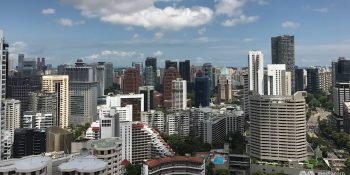SINGAPORE: Singapore’s economy expanded by 2.5 per cent year-on-year in the second quarter of 2017, holding steady from growth in the previous three months on the back of support from the manufacturing sector, advance estimates from the Ministry of Trade and Industry (MTI) showed on Friday (Jul 14).
Year-on-year growth for the first quarter was revised down to 2.5 per cent from 2.7 per cent previously.
On a quarter-on-quarter seasonally adjusted annualised basis, gross domestic product (GDP) grew 0.4 per cent during the April to June period, reversing from the 1.9 per cent contraction in the first quarter.
The manufacturing sector remained the growth driver, with expansion of 8.0 per cent on a year-on-year basis in the second quarter, extending the 8.5 per cent growth in the previous three months. Growth was supported mainly by the electronics and precision engineering clusters, which saw robust expansions on the back of strong external demand for semiconductors and semiconductor manufacturing equipment respectively.
Compared to the past three months, the sector grew by 2.4 per cent, an improvement from the 0.4 per cent growth in the preceding quarter.
The services producing industries grew 1.7 per cent year-on-year, faster than the 1.4 per cent growth in the previous quarter, supported primarily by the transportation & storage and business services sectors.
On a quarter-on-quarter seasonally-adjusted annualised basis, the services producing industries expanded by 0.4 per cent, a reversal from the 2.7 per cent contraction in the preceding quarter.
On the other hand, the construction sector contracted by 5.6 per cent on a year-on-year basis in the second quarter, following the 6.1 per cent decline in the previous quarter. The sector was weighed down by a weakness in both private sector and public sector construction activities.
Quarter-on-quarter, the sector rebounded to grow by 4.3 per cent, compared to the 14.4 per cent contraction in the preceding quarter.
While strong gains in the manufacturing sector have underpinned growth in recent months, economists are cautious as to whether this will last.
UOB economist Francis Tan expects growth in the sector to slow down in the second half of the year to around 5 to 6 per cent, due largely to base effects and a peak in electronics exports.
The services sector, which accounts for about two-thirds of the economy, has also remained soft amid factors such as persistent weakness in local consumption, he said.
This means a potential downside risk for overall GDP growth later in the year.
“All the good story in the GDP being above the 2 per cent mark has been about the manufacturing sector. If manufacturing is coming down, there’s room for overall GDP to come down as well… though I’m still holding on to full-year expectations of 2.4 per cent growth,” he explained.
DBS senior economist Irvin Seah agreed, noting that the economy could see a “moderation towards the tail-end of the year”.
“Such moderation could extend into 2018, where we see annual growth at 2.5 per cent,” he added, citing risks from tighter monetary policies from the US Federal Reserve and a further slowdown in China’s economy.
For the local labour market, economists generally expect continued weakness. “More growth needs to pick up in the services sector before it can spill over positively into the labour market. But even then, we need to see what kinds of jobs are being created and that doesn’t mean that PMETs (professionals, managers, executives and technicians) will necessarily benefit,” said UOB’s Mr Tan.
Layoffs, with the latest being at global food and beverage firm Nestle’s Singapore office, and a hold-off in hiring will likely continue with businesses remaining cautious, economists said.
Friday’s release of the advance GDP estimates for the second quarter are computed largely from data in the first two months of the quarter. They are intended as an early indication of the GDP growth in the quarter, and may be revised when more comprehensive data become available.
Final GDP for the second quarter, including performance by sectors, sources of growth, inflation, employment and productivity, will be released by MTI in August.
